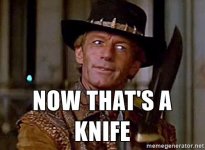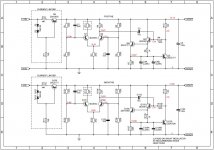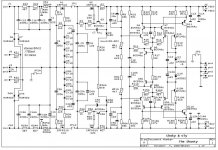Good idea but........consider the current draw.......200 to 300 mils. ..calculate dissipation. You are now replacing the current source with a regulator not much of a net gain except some numbers.
Remember John Curls regulator was working at about 25 Volts and drew about 30 mils per stage.
You will have to heatsink the LM317 as well as the shunt element and have an 5 to 10 volts additional headroom to get the LM317 to works its best. Now a LM317 has to be protected so no more than 40 volts occurs across it under any condition or it fails.
Please also consider that line voltages change so, so does your unregulated voltages therefore have to take into account the extra headroom if the line voltage falls or the extra dissipation if it rises.
I don't disagree with your numbers, great idea but from a practical point of view ....... back to my original question is it worth the extra heat sink and parts to make it work reliably and get some extra performance which is academic in this application from my point of view. .🙂
Jam
Remember John Curls regulator was working at about 25 Volts and drew about 30 mils per stage.
You will have to heatsink the LM317 as well as the shunt element and have an 5 to 10 volts additional headroom to get the LM317 to works its best. Now a LM317 has to be protected so no more than 40 volts occurs across it under any condition or it fails.
Please also consider that line voltages change so, so does your unregulated voltages therefore have to take into account the extra headroom if the line voltage falls or the extra dissipation if it rises.
I don't disagree with your numbers, great idea but from a practical point of view ....... back to my original question is it worth the extra heat sink and parts to make it work reliably and get some extra performance which is academic in this application from my point of view. .🙂
Jam
Last edited:
Jeff
I am just wondering, why you think you need 56V rails?
Have you actually measured what peak Voltage swings you have across your speakers at the spl you listen to music?
I personally think 30V rails is generally adequate for home use, especially for us old blokes that prefer to listen to music for enjoyment, rather than at night-club spl levels.
I am just wondering, why you think you need 56V rails?
Have you actually measured what peak Voltage swings you have across your speakers at the spl you listen to music?
I personally think 30V rails is generally adequate for home use, especially for us old blokes that prefer to listen to music for enjoyment, rather than at night-club spl levels.
Last edited:
Yeah, but I still need my 100 Watts........😀
Attachments
Last edited:
Jeff
I am just wondering, why you think you need 56V rails?
46V. But the reason is a big listening room and not very efficient Maggies.
Attachments
46V. But the reason is a big listening room and not very efficient Maggies.
Yeah fair enough.
I would still do the measurement though, it will be very informative.
I don't have a SPICE model for 2SD2081.
I tried it with a TIP122, but I couldn't make it perform as well as the MOSFET. (I'm getting 5uV residual ripple with a 20mOhm output impedance, compared to 2uV and 9mOhm for the IRFP250.)
I tried it with a TIP122, but I couldn't make it perform as well as the MOSFET. (I'm getting 5uV residual ripple with a 20mOhm output impedance, compared to 2uV and 9mOhm for the IRFP250.)
I did learn some new things trying to optimise the Darlington, and went back and applied them to the MOSFET version. It now out-performs the original opamp regulator:
85dB attenuation
2uV residual ripple
6mOhm output impedance
85dB attenuation
2uV residual ripple
6mOhm output impedance
Jeff,
The TIP122 is not a great device maybe you should try a discreet darlington.(key is high beta)
I forgot to mention, to try a current mirror on the differential, should improve drive to darlington or mosfet.
Also try adding saome capacitancr after R5 and R6, say about 1000uF.
Jam
P.S. Nice listening room.
The TIP122 is not a great device maybe you should try a discreet darlington.(key is high beta)
I forgot to mention, to try a current mirror on the differential, should improve drive to darlington or mosfet.
Also try adding saome capacitancr after R5 and R6, say about 1000uF.
Jam
P.S. Nice listening room.
Last edited:
It now out-performs the original opamp regulator:
It's easy, isn't it.
Here's what I currently have:

I've tried the following:
1) lowering LTP gain (increasing resistors in LTP)
2) lowering VAS gain (adding source degeneration)
3) adding Miller compensation
4) adding a Zobel to the MOSFET gate drive
5) increasing the MOSFET gate stopper
6) adding a Zobel to the output
7) adding Zobels to both LTP inputs (reference and feedback)
I tried Miller comp up to 1n; Zobels were something like 100n/10R.
No joy yet....
I've tried the following:
1) lowering LTP gain (increasing resistors in LTP)
2) lowering VAS gain (adding source degeneration)
3) adding Miller compensation
4) adding a Zobel to the MOSFET gate drive
5) increasing the MOSFET gate stopper
6) adding a Zobel to the output
7) adding Zobels to both LTP inputs (reference and feedback)
I tried Miller comp up to 1n; Zobels were something like 100n/10R.
No joy yet....
Attachments
- Home
- Amplifiers
- Pass Labs
- JamJar: an HPA-1-inspired power amp




